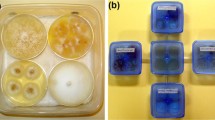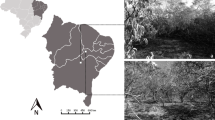Abstract
The ability of Tasmanian bettongs (Bettongia gaimardi) to locate hypogeous fungi (their main diet) was tested in a controlled laboratory situation. Bettongs dug directly over buried fungi significantly more often than they did over buried glass marbles or over disturbed soil. This ability was not enhanced as they gained experience. Bettongs dug more often over buried filter paper onto which fungus extract was absorbed than over control papers, and showed no discrimination between the outer and inner layers of the fungi. They preferred the odor of whole fungi to individual volatile compounds. They showed no reaction to the odor of the steroid ergosterol.
Similar content being viewed by others

References
Bengtsson, G., Hedlund, K., andRundgren, S. 1991. Selective odor perception in the soil CollembolaOnychiurus armatus.J. Chem. Ecol. 17:2113–2124.
Burbidge, A. 1983. Burrowing bettong, pp. 187–188,in R. Strahan (ed.). The Complete Book of Australian Mammals. Angus and Robertson, Melbourne.
Claridge, A.W., Tanton, M.W., Seebeck, J.H., Cork, S.J., andCunningham, R.B. 1992. Establishment of ectomycorrhizae on the roots of two species ofEucalyptus from fungal spores contained in the faeces of the long-nosed potoroo (Potorous tridactylus).Aust. J. Ecol. 17:207–218.
Claus, R., Hoppen, H.O., andKarg, H. 1981. The secret of truffles: A steroidal pheromone?Experientia 37:1178–1179.
Delroy, L., Earl, J., Radbone, I., Robinson, A., andHewett, M. 1986. The breeding and reestablishment of the brush-tailed bettong,Bettongia penicillata, in South Australia.Aust. Wild. Res. 13:387–396.
Holling, C.S. 1958. Sensory stimuli involved in the location and selection of sawfly cocoons by small mammals.Can. J. Zool. 36:633–653.
Howard, R.E., Marsh, R.E., andCole, R.E. 1968. Food detection by deer mice using olfactory rather than visual cues.Anim. Behav. 16:13–17.
Hutchinson, S.A. 1971. Biological activity of volatile fungal metabolites.Trans. Br. Mycol. Soc. 57:185–200.
Kotter, M., andFarentinos, R. 1984. Tassel-eared squirrels as spore dispersal agents of hypogeous mycorrhizal fungi.J. Mammal. 65:684–687.
Maser, C., Maser, Z., andMolina, R. 1988. Small-mammal mycophagy in rangelands of central and southeastern Oregon.J. Range Manage. 41:309–312.
Pacioni, G., Bologna, M.A., andLaurenzi, M. 1991. Insect attraction byTuber: A chemical explanation.Mycol. Res. 95:1359–1363.
Ride, W.D.L., andWilson, G.R. 1982. The conservation status of Australian mammals, pp. 27–45,in R.H. Groves and W.D.L. Ride (eds.). Species at Risk: Research in Australia. Australian Academy of Science, Canberra.
Talou, T., Gaset, A., Delmas, M., Kulifaj, M., andMontant, C. 1990. Dimethyl sulphide: The secret for black truffle hunting by animals?Mycol. Res. 94:277–278.
Taylor, R.J. 1992. Seasonal changes in the diet of the Tasmanian bettong (Bettongia gaimardi), a mycophagous marsupial.J. Mammal. 73:408–414.
Trappe, J.M. 1962. Fungus associates of ectotrophic mycorrhizae.Bot. Rev. 28:538–606.
Author information
Authors and Affiliations
Rights and permissions
About this article
Cite this article
Donaldson, R., Stoddart, M. Detection of hypogeous fungi by Tasmanian bettong (Bettongia gaimardi: Marsupialia; Macropodoidea). J Chem Ecol 20, 1201–1207 (1994). https://doi.org/10.1007/BF02059754
Accepted:
Issue Date:
DOI: https://doi.org/10.1007/BF02059754



